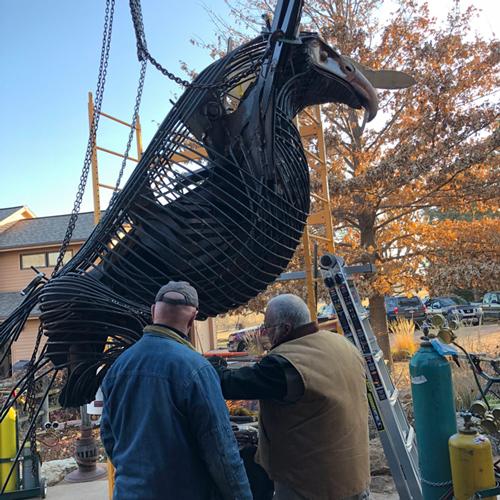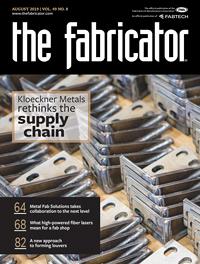- FMA
- The Fabricator
- FABTECH
- Canadian Metalworking
Categories
- Additive Manufacturing
- Aluminum Welding
- Arc Welding
- Assembly and Joining
- Automation and Robotics
- Bending and Forming
- Consumables
- Cutting and Weld Prep
- Electric Vehicles
- En Español
- Finishing
- Hydroforming
- Laser Cutting
- Laser Welding
- Machining
- Manufacturing Software
- Materials Handling
- Metals/Materials
- Oxyfuel Cutting
- Plasma Cutting
- Power Tools
- Punching and Other Holemaking
- Roll Forming
- Safety
- Sawing
- Shearing
- Shop Management
- Testing and Measuring
- Tube and Pipe Fabrication
- Tube and Pipe Production
- Waterjet Cutting
Industry Directory
Webcasts
Podcasts
FAB 40
Advertise
Subscribe
Account Login
Search
Healing veterans' invisible wounds of war through metal art
Warrior StoryField helps military veterans express and process complex thoughts and emotions
- By Amanda Carlson and Ann Thompson
- August 15, 2019
- Article
- Arc Welding

Over the last six years more than 50 veterans from six wars, their families, and local civilians have been fabricating a 16-foot-tall dragon and an 18-ft.-tall phoenix. When finished, they hope to put it on display in a Colorado park.
Military veterans who have experienced combat are profoundly changed, regardless of the conflict or generation. Some even say the real war began when they returned home to their civilian life. That’s why a grassroots organization called Warrior StoryField (WSF) uses metal art as a vehicle for veterans to express and process complex thoughts and emotions.
Spearheaded by co-founder Robert Bellows, WSF is a labor of love that was born through his own need for expression. He is not a veteran, but that doesn’t mean he can’t identify with their demons. He can, because he’s got them too. As a younger man he suffered bouts of severe depression, which he dealt with in an unhealthy way. That is, until he discovered metal sculpture. Bellows found that the process of expression through metal sculpture was therapeutic and it helped fill the void. It was a chance encounter with friends that made him realize that perhaps this form of expression could help others too.
The Dragon and the Phoenix
Six years ago two of Bellows’ friends, Brad Gallup (U.S. Air Force) and Danny Moore (U.S. Army)—both Iraq War veterans—showed up at his shop. At the time, Bellows was working on a rooster sculpture, and both Gallup and Moore asked if they could help him out.
“I thought they’d be here for like a day, but they stayed for nine months. In the process of them coming back every day we got to talking about war issues, the ghosts, and the demons. It wasn’t like I was asking questions—I never asked direct questions about their war experiences. But I did ask how they wanted to express themselves through art. They just offered these bits of information. And slowly it just woke me up and made me realize that as a civilian I could do something.
“I know what art has done for me. So, I started handing them the decisions on where the scales go or where the feathers go on the rooster and how to shape them. I stood in the back and I welded while they pounded and shaped. It got to be really fun.”
After the sculpture was complete, the three men decided to keep going, except on a larger scale. In 2013 they invited other veterans, their families, and civilians to the shop to embark on a massive metal sculpture dedicated to veterans, designed by veterans, and fabricated by veterans.
Over the last six years more than 50 veterans from six wars, their families, and local civilians have been fabricating a 16-foot-tall dragon representing the fierce warrior, and an 18-ft.-tall phoenix—a bird of rebirth—symbolizing the men and women who return home from war, fundamentally changed on the battlefield and seeking restoration. Locked in an eternal stare down, the space between the two mythological creatures is the “story field” that represents the soul. When the sculptures are complete, Bellows said he hopes they will be on permanent display in a local Colorado park.
The Process of Art
One of the challenges of opening his fab shop to people who have no experience with metalworking is teaching them how to do it safely. But after that the focus isn’t on perfection, it’s on the process. He uses sensation and sound to teach the welding component and claims that tactic allows him to “get someone welding a pretty damn good bead in about 10 minutes.”
“That doesn’t mean they don’t get air into the weld or burn the tip shut. We go through a lot of tips!” Bellows laughed.
While Bellows hasn’t officially set a limit on how many people he can accommodate at one time, he finds that the fewer people there are, the better.
“The purpose of this isn’t to build sculptures. It’s to have a conversation about the emotional expression of the sculptures. Working on the sculptures is the common purpose that draws us together, and we keep coming back to go deeper into that conversation.”
Interested in Helping?
WSF operates on a shoestring budget, meaning Bellows has a little bit of equipment, like a few power sources from Miller Electric, a Powermax65 from Hypertherm, and a CNC plasma table from ArcLight Dynamics. He prefers it that way as it allows the group to problem-solve with wit and the tools that they have.
“I like that way of making art because it forces innovation and collaboration,” Bellows explained.
Bellows estimates another four years’ worth of work before the sculptures are complete. That means fours years of procuring materials, PPE, consumables, and machine use that must be taken into consideration.“We go through consumables like crazy. We destroy gloves. In fact, I’ve never met a hot place you couldn’t put a glove. We destroy face shields as well. It happens.”
Bellows said simple $10 donations are huge in allowing this project to continue.
If you’d like to learn more about Warrior StoryField, find out how you can help, or donate to the project, visit warriorstoryfield.org.
Ann Thompson is marketing specialist at Hypertherm Inc., 800-643-0030, ann.thompson@hypertherm.com.
.About the Authors

Amanda Carlson
2135 Point Blvd
Elgin, IL 60123
815-227-8260
Amanda Carlson was named as the editor for The WELDER in January 2017. She is responsible for coordinating and writing or editing all of the magazine’s editorial content. Before joining The WELDER, Amanda was a news editor for two years, coordinating and editing all product and industry news items for several publications and thefabricator.com.
Ann Thompson
Marketing Specialist
Hypertherm Inc.
800-643-0030
Related Companies
subscribe now

The Fabricator is North America's leading magazine for the metal forming and fabricating industry. The magazine delivers the news, technical articles, and case histories that enable fabricators to do their jobs more efficiently. The Fabricator has served the industry since 1970.
start your free subscription- Stay connected from anywhere

Easily access valuable industry resources now with full access to the digital edition of The Fabricator.

Easily access valuable industry resources now with full access to the digital edition of The Welder.

Easily access valuable industry resources now with full access to the digital edition of The Tube and Pipe Journal.
- Podcasting
- Podcast:
- The Fabricator Podcast
- Published:
- 04/16/2024
- Running Time:
- 63:29
In this episode of The Fabricator Podcast, Caleb Chamberlain, co-founder and CEO of OSH Cut, discusses his company’s...
- Trending Articles
Tips for creating sheet metal tubes with perforations

Supporting the metal fabricating industry through FMA

JM Steel triples capacity for solar energy projects at Pennsylvania facility

Fabricating favorite childhood memories

Omco Solar opens second Alabama manufacturing facility

- Industry Events
16th Annual Safety Conference
- April 30 - May 1, 2024
- Elgin,
Pipe and Tube Conference
- May 21 - 22, 2024
- Omaha, NE
World-Class Roll Forming Workshop
- June 5 - 6, 2024
- Louisville, KY
Advanced Laser Application Workshop
- June 25 - 27, 2024
- Novi, MI



























